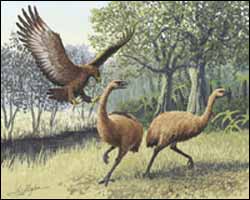The giant eagle of Middle Earth

The giant Haast’s eagle attacking the extinct New Zealand moa. Illustration: John Megahan.
Peter Jackson’s JRR Tolkien-inspired film trilogy Lord of the Rings features enormous eagles swooping down to rescue Sam and Frodo from a desolate New Zealand landscape masquerading as Mordor. The image of giant eagles flying around New Zealand, while fanciful, is not so far-fetched as it might appear. New genetic data published in the freely-available online journal PLoS Biology this week from researchers at Oxford and Canterbury Universities shed new light on the evolution of the extinct giant eagle that once ruled the skies in New Zealand.
Before human settlement 700 years ago, New Zealand had no terrestrial mammals, apart from three species of bats. Instead, about 250 species of bird dominated the terrestrial ecosystem. At the top of the food chain was the extinct Haast’s eagle. With a 2.5-3m wingspan weighing in at between 10 and 14 kg, Haast’s eagle was about 30-40% heavier than the largest living bird of prey (the harpy eagle of Central and South America) and was approaching the upper weight limit of powered flight. Haast’s eagle is the only eagle known to have been the top predator in a major terrestrial ecosystem, hunting moa, the giant herbivorous birds of New Zealand, weighing up to 200 kg. Evidence of eagle strikes remain, as holes and rents torn into the bones of moa, which show that the eagle struck from the side, gripped the moa’s pelvic area with one foot, and killed with a single strike by the other foot to the neck or head. The eagle is thought to be the Hokioi of Maori oral history and is recorded in rock art, and artifacts shaped from eagle bone prove that the eagle co-existed with early Polynesians. However, there is no evidence that humans were targets for this huge aerial predator.
In the research paper, New Zealand researchers at Oxford University’s Ancient Biomolecules Center run by Professor Alan Cooper extracted DNA from fossil eagle bones about 2000 years old. Dr Michael Bunce, who performed the research, said, “When I began the research project with graduate student Marta Szulkin, it was to prove the relationship of the extinct Haast’s eagle with the large Australian wedge-tailed eagle. The DNA results were so radical that at first we questioned their authenticity.” The research team demonstrated that the New Zealand giant was in fact related to one of the world’s smallest eagles–the “Little Eagle” from Australia and New Guinea, which typically weighs under 1 kg. “Even more striking was how closely genetically related the two eagle species were. We estimate that their common ancestor lived less than a million years ago. It means an eagle arrived in New Zealand and increased in weight by 10-15 times over this period; such rapid size change is unprecedented in terrestrial vertebrates,” Bunce said.
New Zealand-based palaeobiologist Dr Richard Holdaway, who was part of the research team and who has studied the eagle for the past 20 years, speculated as to how and why Haast’s eagle grew to be so big, so quick: “The size of available prey and the absence of predators are, we think, the key factors driving the size increase. The large herbivores were available, and after killing a moa, an eagle would have been able to feed unhindered.” Holdaway goes on to say that “it’s great to see New Zealand’s extinct birds the focus of international research. There are so many unanswered questions about our biological past that ancient DNA can address, and the integration of molecular and morphological information can only benefit ecological and evolutionary research.” Research into DNA from ancient moa “poop” and from soil in former petrel breeding colonies is currently underway.
Media Contact
All latest news from the category: Ecology, The Environment and Conservation
This complex theme deals primarily with interactions between organisms and the environmental factors that impact them, but to a greater extent between individual inanimate environmental factors.
innovations-report offers informative reports and articles on topics such as climate protection, landscape conservation, ecological systems, wildlife and nature parks and ecosystem efficiency and balance.
Newest articles

Cracking the code of DNA circles in cancer
Stanford Medicine-led team uncovers potential therapy. ecDNA catapults into spotlight. A trio of research papers from Stanford Medicine researchers and their international collaborators transforms scientists’ understanding of how small DNA…

Imaging nuclear shapes by smashing them to smithereens
Scientists use high-energy heavy ion collisions as a new tool to reveal subtleties of nuclear structure with implications for many areas of physics. Scientists have demonstrated a new way to…

Polypropylene recyclates
… best quality at minimum cost thanks to precise stabilisation. Online characterisation, plastic formulations, more profitable. All organic substances, including plastics such as polypropylene (PP), undergo auto-oxidation in the presence…



